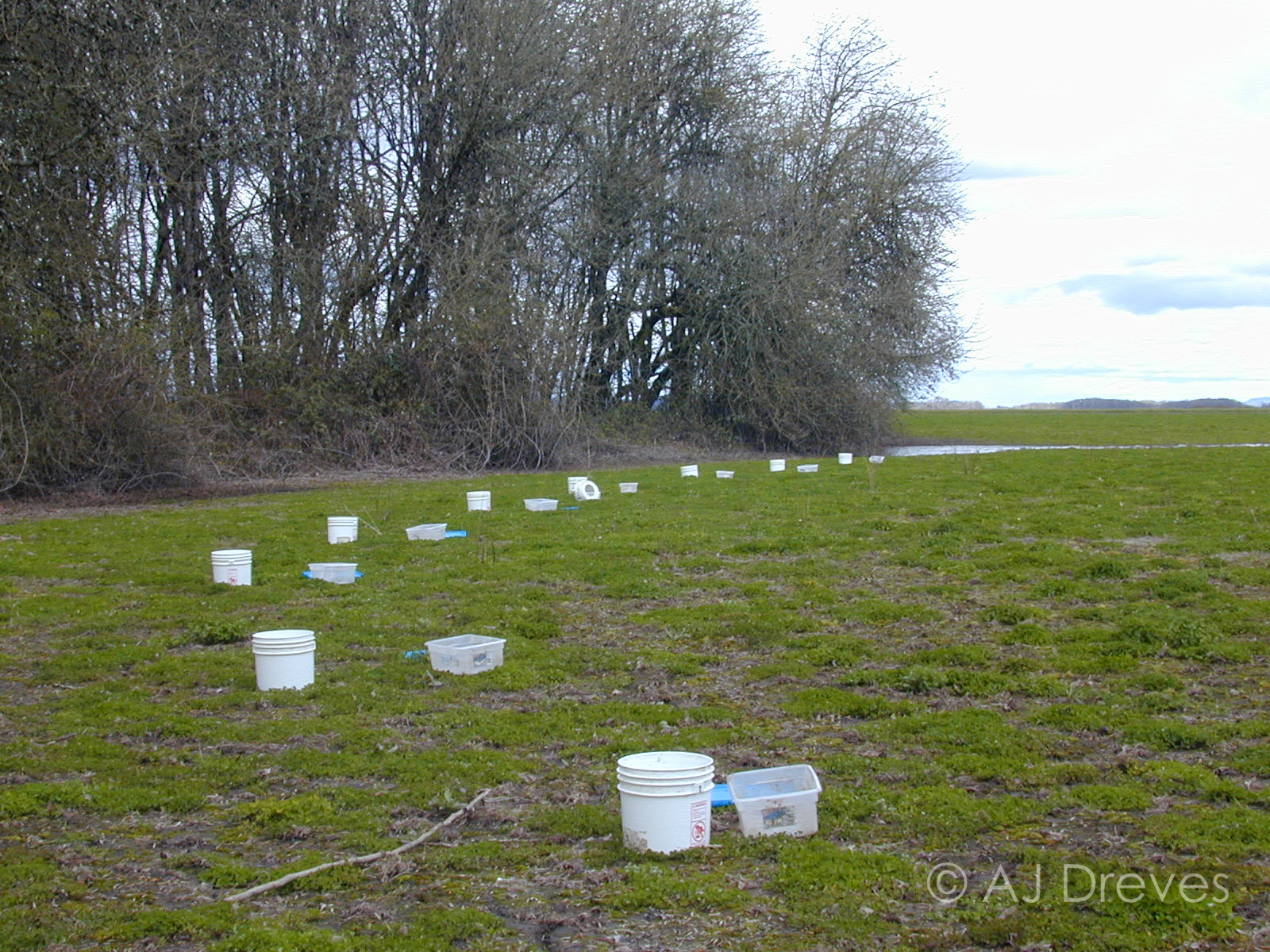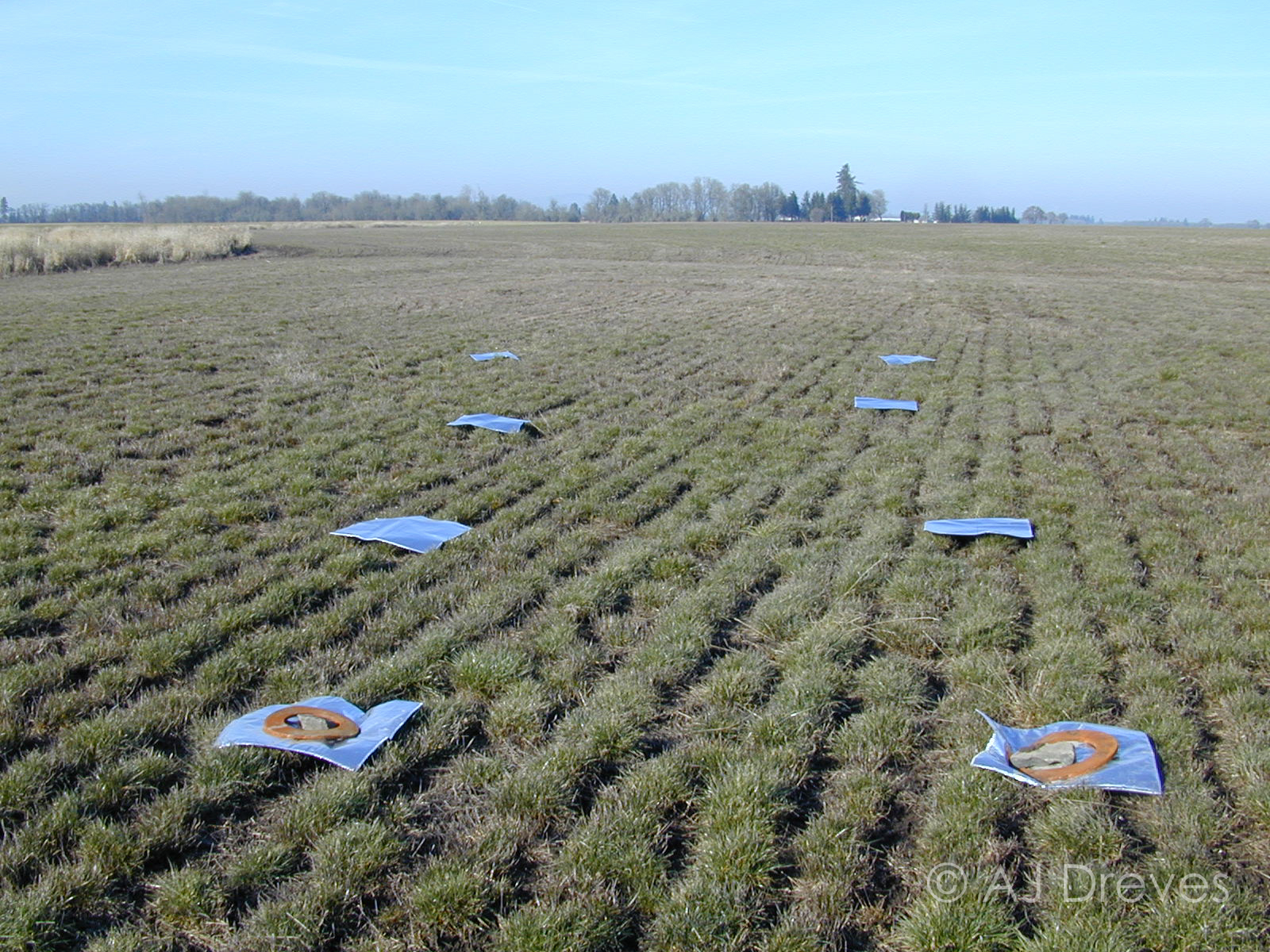Factors affecting Bait Efficacy
Success of bait applications varies between fields, years, season, bait type, slug age, etc. Biotic (living organisms like birds and fungal diseases) and abiotic factors (non-living organisms like weather or soil type) can affect levels of slug control achieved from bait products. A single molluscide bait application typically ranges from 10 to 60% slug control.
-
Commercially-available baits have a hard time suppressing slugs below damaging levels, especially if populations are too high from beginning of treatment.
-
Monitor before and after baiting. Several bait applications, about 10-14 days apart, may be necessary to control slugs of varying ages in a particular area.
-
Field life of bait products can be short (4-5 days active life); in some cases a half-life is surpassed in less than half a day. It has been reported that 60% of the efficacy of baits occurs on the first day of application. The mortality of slugs using metaldehyde baits can drop off sharply after 48 hours. Pick the “right night for monitoring and baiting; When temperature, wind, moisture is favorable and slugs are active above ground.
-
Heavy migration of slugs can occur each night from borders or adjacent plots that affect baiting. Research plot size must be considered when interpreting results when testing baits and extrapolating to field-size situations. Many researchers in the Northwest believe that greater or equal to 50 x 50 feet plots is an adequate size to minimize movement across plots for testing bait efficacy.
-
Optimum conditions for baiting: Temperature: 50 -70°F; Little to no winds: <5 mph, high humidity, light rain or ground moist; and at nighttime when slugs are active.
-
Treat Sept - Oct (FALL) and Feb – May (Spring) before peak egg-laying.
Nightcrawlers. Population size of nightcrawlers, Lumbricus terrestris, in the field affects control of slugs when using baits—while the worms are not killed by baits.
-
Nightcrawlers can reduce bait in the field by 20% by pulling the pellets underground.
-
In fields with good soil tilth and high nightcrawler populations, 90% of the bait can be depleted by earthworm scavenging within 4-5 days of application.
-
Only 25% of new seedlings are protected by bait when earthworms are active.
Quantity Consumed | Recovery Ability. Effectiveness of bait is dependent on the quantity consumed by a slug; and there is a balance between the bait formulation which produces a sublethal dose and that which would be a repellent.
-
Slugs can recover from high rates of metaldehyde poisoning, if ingestion of bait is followed by 4 days of lower temperature within moist soil and/or access to sufficient water.
-
Slugs that survive poisoning by baits tend to be deterred by feeding on similar baits. This behavior is similar to their aversion to eating baits that have previously poisoned them.
-
Finding bait is random as slug likely have short range attraction, so density of bait spread is important to increase chances of finding it.
Weather Conditions. Environmental conditions such as cold temperatures (< 34°F), high wind (> 5-mph), or heavy rains affect slug activity and bait efficacy.
-
Temperature is important to the success of metaldehyde. At 44° F (7° C), treatment will likely fail, especially if the weather is extremely wet and too cold (<32°F), but at 68°F (20°C), treatment is more likely to be successful. Extreme high and low temperatures equate to low activity, with little to no feeding.
-
Metaldehyde baits are 50% less toxic to slugs at lower temperatures and are hence less effective in late fall to early winter months.
-
Mature slugs are most active on the surface in the fall especially after the first rains before eggs are deposited. Apply bait after heavy rains when temperature and winds are suitable and optimal conditions are predicted several days after the application.
-
Baits applied after Nov. 1 (estimated) may not have an effect on inactive slugs. Fall baiting is best after rains, between September and October, and March and April, if optimal conditions persist.
-
Adverse weather can keep slugs close to the crowns of established plants, hidden under residue, underground in cracks, and within earthworm or mole burrows for protection; so slugs less likely to come across bait during these times.
-
Bait efficacy is reduced when soil temperatures are < 50°F, with most baits performing well at > 63°F.
-
Cool damp nights, followed by high temperatures (80°F) and sun, will desiccate and kill slugs quicker.
-
Slug activity can be delayed 4-5 days after a freeze event, even when followed by warm, wet conditions that otherwise were appropriate for slug activity.
-
Heavy rains following bait application can lead to control failure because of reduced residual action.
Bait type. Level of attraction (e.g., millrun wheat bran), toxicant content, base carrier and/or additives, application rate, rain fastness, palatability of baits,
-
Some formulations are more resistant to water than others; and the palatability of different food baits varies according to slug species and age.
-
Slug baits have a rapid breakdown of active ingredient (metaldehyde) from water (precipitation, moist soil) and by soil microbes.
-
Food baits are best applied in the late afternoon, early evening under humid conditions, food baits will only be effective for 3--4 days before mold grows over them.
-
Rain or heavy dew may cause pellets to swell and break apart.
- Some pellets require dry or wet weather to increase longevity in the field.
Slug Age and Levels. Small immature slugs are typically more difficult to kill than mature individuals that are laying eggs.
-
There are differences in sensitivity between slug ages to baits. As a slug matures, it is increasing more susceptible to baits than the immature slug stage.
-
Neonates do not have the developed mouthparts to feed on baits, preferring algae and fungi; and do not move as far as do adults.
-
Slugs prefer most field crops, particularly seedling grasses over mature grasses or baits.
-
There are differences in feeding strategies between different slug species.




